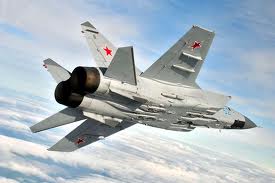MiG-31 Foxhund Fighter
The MiG-31 ‘Foxhound’ was developed to counter the threat posed by new low-level strike aircraft and cruise missiles, complementing the Su-27 in service, and using its ultra-long-range capability to fill gaps in Russia’s ground-based radar chain. A two-seat derivative of the MiG-25 ‘Foxbat’ airframe, the ‘Foxhound’ introduced an all-new structure, a new wing planform with small LERXes, Soloviev D-30F-6 turbofans and a new undercarriage. The Ye-155MP prototype flew on 16 September 1975 and series production of 280 MiG-31 s began in 1979.
The MiG-31 featured a flat belly with four missile recesses for its primary armament, which consisted of R-33 (AA-9 ‘Amos’) AAMs. The ‘Foxhound’ also carries a scabbed-on GSh-6-23 six-barrelled 23-mm cannon pod and has underwing pylons for two AA-6 ‘Acrid’ or four AA-8 ‘Aphid’ missiles. The new ‘Zaslon’ radar had a phased-array antenna, increasing range and allowing faster, more accurate beam pointing. Ten targets can be tracked simultaneously, and four engaged. Groups of four MiG-31s can operate independently of ground control, covering a 900-km (560-mile) swathe of territory, with the leader automatically controlling his wingmen.
The MiG-31 01-DZ introduced a retractable inflight refuelling probe, while the MiG-31B also had an improved radar with better ECCM, and a new digital processor. Existing aircraft brought up to the same standard were designated MiG-31 BS.
Two MiG-31 D prototypes were produced as test-beds for a new anti-satellite missile. The MiG-31E, MiG-31F and MiG-31FE designations were applied to unbuilt export and upgrade configurations, while the MiG-31BM is a proposed defence suppression variant.
 The improved MiG-31M interceptor variant was built in prototype form only. The MiG-31 M carried six R-37 long-range AAMs in three side-by-side recesses under the belly, each accommodating tandem pairs of missiles. Its new radar had a 1,4-m diameter antenna and could simultaneously engage six targets. A fully-retractable IRST was fitted, and MiG-31 Ms also have a redesigned rear cockpit, with three CRT MFDs. Other changes include a one-piece canopy and windscreen, a retractable IFR probe, large wingtip ESM pods, and aerodynamic refinements. Redesigned LERXes improved high AoA handling, and a bulged spine gave increased fuel capacity, but development was abandoned due to lack of funding. The first of six prototypes made its maiden flight on 21 December 1985.
The improved MiG-31M interceptor variant was built in prototype form only. The MiG-31 M carried six R-37 long-range AAMs in three side-by-side recesses under the belly, each accommodating tandem pairs of missiles. Its new radar had a 1,4-m diameter antenna and could simultaneously engage six targets. A fully-retractable IRST was fitted, and MiG-31 Ms also have a redesigned rear cockpit, with three CRT MFDs. Other changes include a one-piece canopy and windscreen, a retractable IFR probe, large wingtip ESM pods, and aerodynamic refinements. Redesigned LERXes improved high AoA handling, and a bulged spine gave increased fuel capacity, but development was abandoned due to lack of funding. The first of six prototypes made its maiden flight on 21 December 1985.
